TESLA MODEL S 2014 Owner's manual (Europe)
Manufacturer: TESLA, Model Year: 2014, Model line: MODEL S, Model: TESLA MODEL S 2014Pages: 152, PDF Size: 17.5 MB
Page 121 of 152
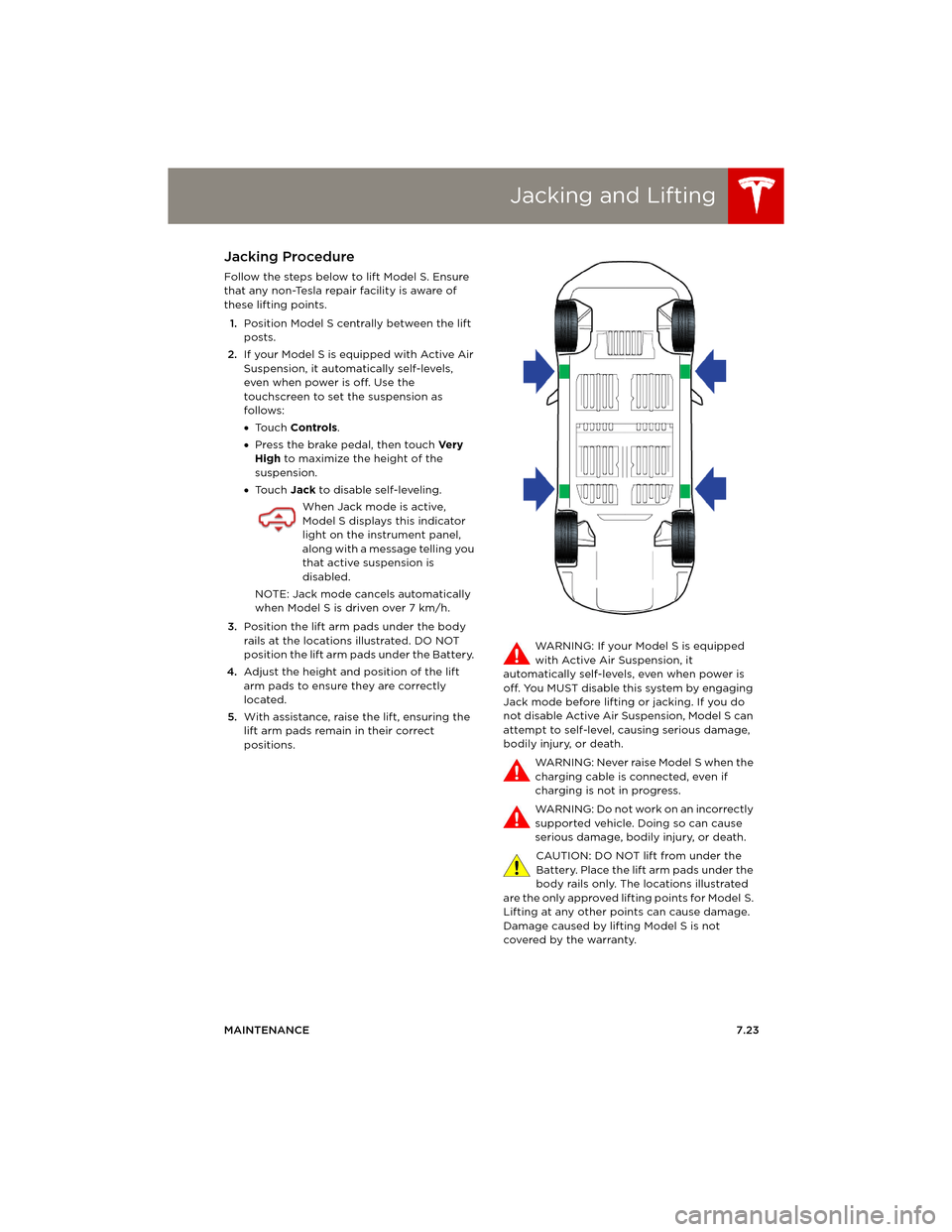
Jacking and Lifting
MAINTENANCE7.23
Jacking and LiftingJacking Procedure
Follow the steps below to lift Model S. Ensure
that any non-Tesla repair facility is aware of
these lifting points.
1.Position Model S centrally between the lift
posts.
2.If your Model S is equipped with Active Air
Suspension, it automatically self-levels,
even when power is off. Use the
touchscreen to set the suspension as
follows:
•To u c h Controls.
•Press the brake pedal, then touch Ve r y
High to maximize the height of the
suspension.
•To u c h Jack to disable self-leveling.
When Jack mode is active,
Model S displays this indicator
light on the instrument panel,
along with a message telling you
that active suspension is
disabled.
NOTE: Jack mode cancels automatically
when Model S is driven over 7 km/h.
3.Position the lift arm pads under the body
rails at the locations illustrated. DO NOT
position the lift arm pads under the Battery.
4.Adjust the height and position of the lift
arm pads to ensure they are correctly
located.
5.With assistance, raise the lift, ensuring the
lift arm pads remain in their correct
positions.WARNING: If your Model S is equipped
with Active Air Suspension, it
automatically self-levels, even when power is
off. You MUST disable this system by engaging
Jack mode before lifting or jacking. If you do
not disable Active Air Suspension, Model S can
attempt to self-level, causing serious damage,
bodily injury, or death.
WARNING: Never raise Model S when the
charging cable is connected, even if
charging is not in progress.
WARNING: Do not work on an incorrectly
supported vehicle. Doing so can cause
serious damage, bodily injury, or death.
CAUTION: DO NOT lift from under the
Battery. Place the lift arm pads under the
body rails only. The locations illustrated
are the only approved lifting points for Model S.
Lifting at any other points can cause damage.
Damage caused by lifting Model S is not
covered by the warranty.
book.book Page 23 Friday, July 19, 2013 12:53 PM
Page 122 of 152
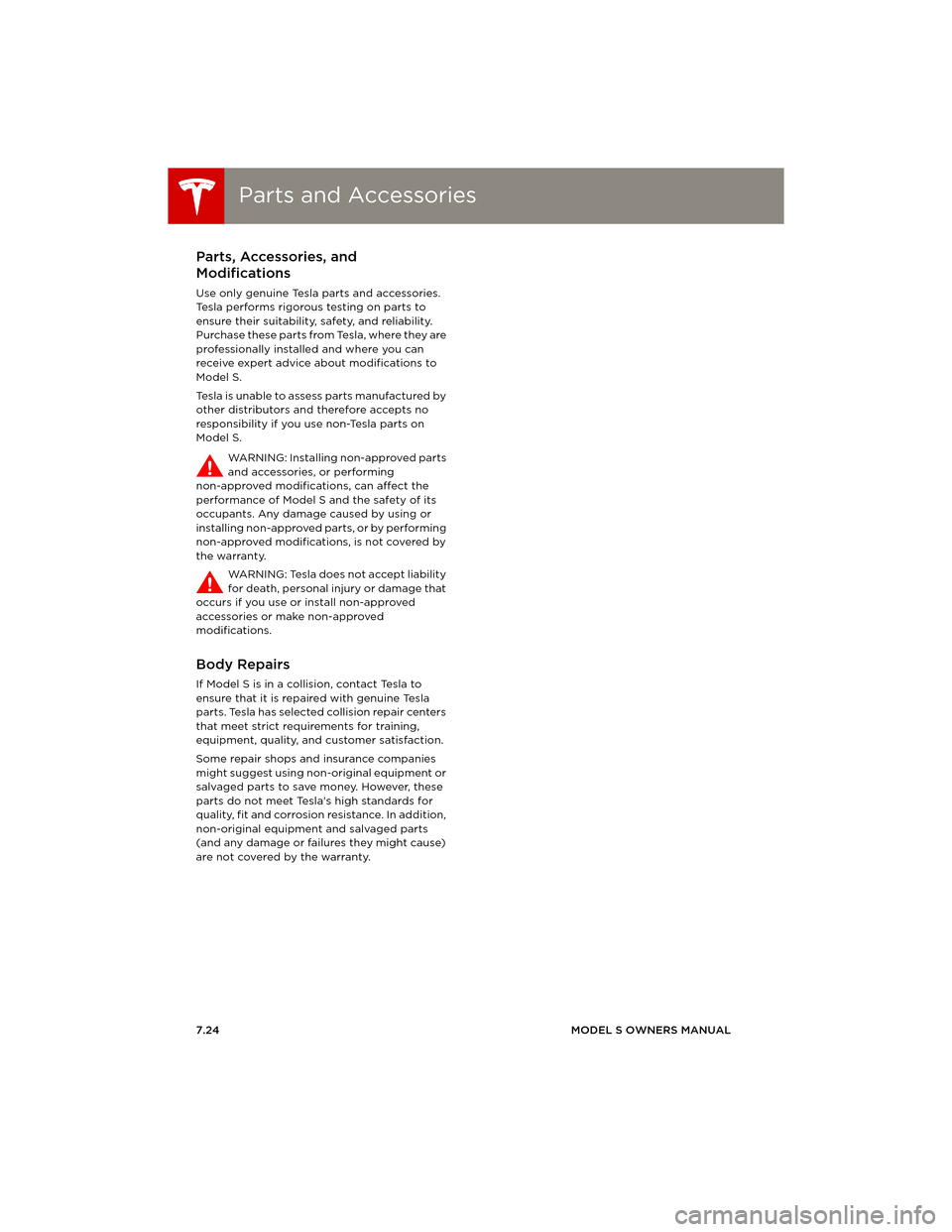
Parts and AccessoriesParts and Accessories
7.24MODEL S OWNERS MANUAL
Parts and AccessoriesParts, Accessories, and
Modifications
Use only genuine Tesla parts and accessories.
Tesla performs rigorous testing on parts to
ensure their suitability, safety, and reliability.
Purchase these parts from Tesla, where they are
professionally installed and where you can
receive expert advice about modifications to
Model S.
Tesla is unable to assess parts manufactured by
other distributors and therefore accepts no
responsibility if you use non-Tesla parts on
Model S.
WARNING: Installing non-approved parts
and accessories, or performing
non-approved modifications, can affect the
performance of Model S and the safety of its
occupants. Any damage caused by using or
installing non-approved parts, or by performing
non-approved modifications, is not covered by
the warranty.
WARNING: Tesla does not accept liability
for death, personal injury or damage that
occurs if you use or install non-approved
accessories or make non-approved
modifications.
Body Repairs
If Model S is in a collision, contact Tesla to
ensure that it is repaired with genuine Tesla
parts. Tesla has selected collision repair centers
that meet strict requirements for training,
equipment, quality, and customer satisfaction.
Some repair shops and insurance companies
might suggest using non-original equipment or
salvaged parts to save money. However, these
parts do not meet Tesla's high standards for
quality, fit and corrosion resistance. In addition,
non-original equipment and salvaged parts
(and any damage or failures they might cause)
are not covered by the warranty.
book.book Page 24 Friday, July 19, 2013 12:53 PM
Page 123 of 152

8.1
SPECIFICATIONS
Identification Labels
Vehicle Identification Number..................... 8.2
Vehicle Loading
Load Capacity Labeling ................................. 8.3
Calculating Load Limits ................................ 8.4
Towing a Trailer ............................................... 8.4
Dimensions and Weights
Exterior Dimensions ........................................ 8.5
Weights ................................................................ 8.5
Subsystems
Motor .................................................................... 8.6
Transmission...................................................... 8.6
Steering ............................................................... 8.6
Brakes .................................................................. 8.6
Suspension .......................................................... 8.7
Battery - 12V ....................................................... 8.7
Battery - High Voltage ................................... 8.7
Wheels and Tires
Wheel Specifications ..................................... 8.8
Wheel Alignment Values .............................. 8.8
Tire Specifications........................................... 8.8
Understanding Tire Markings..................... 8.10
book.book Page 1 Friday, July 19, 2013 12:53 PM
Page 124 of 152
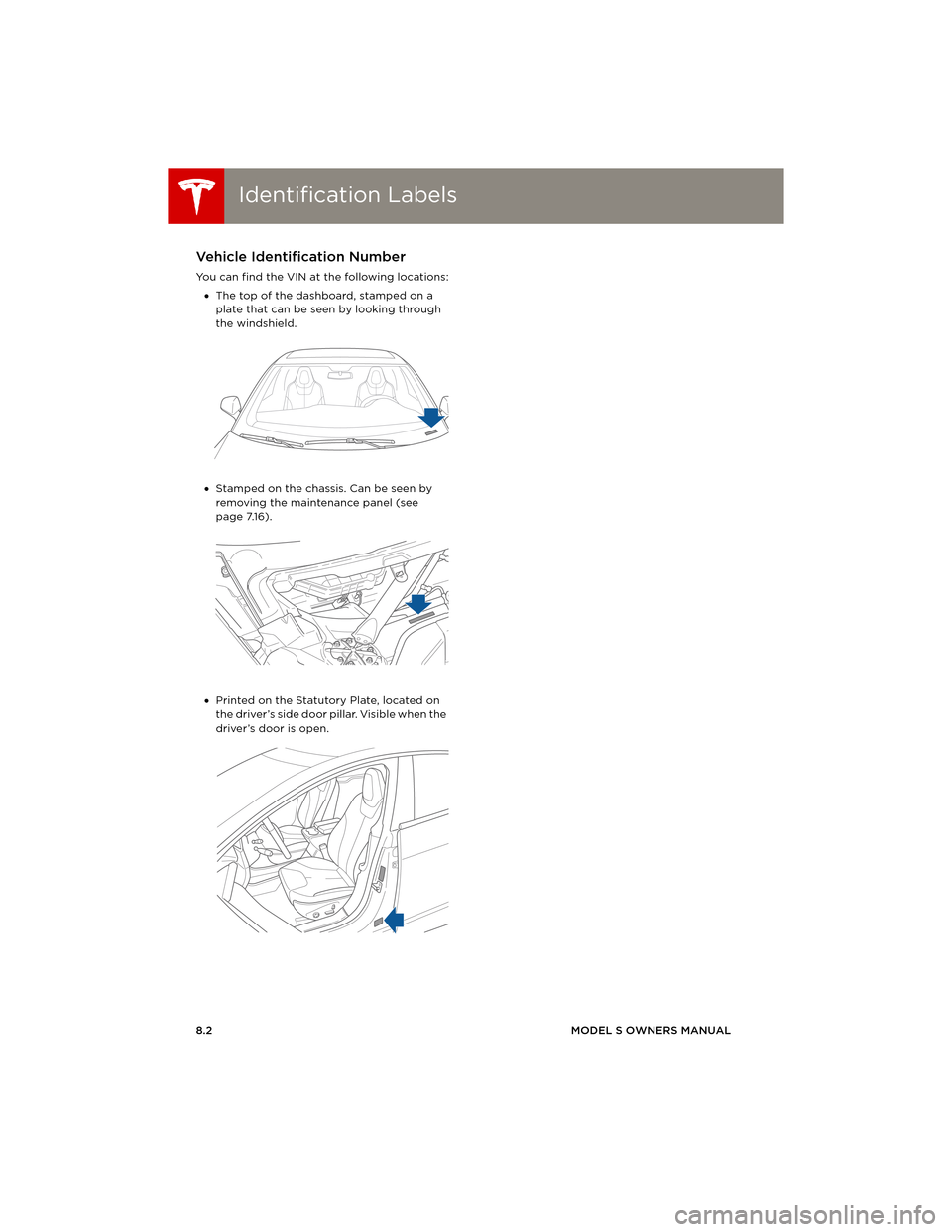
Identification LabelsIdentification Labels
8.2MODEL S OWNERS MANUAL
SPECIFICATIONS
Identification LabelsVehicle Identification Number
You can find the VIN at the following locations:
•The top of the dashboard, stamped on a
plate that can be seen by looking through
the windshield.
•Stamped on the chassis. Can be seen by
removing the maintenance panel (see
page 7.16).
•Printed on the Statutory Plate, located on
the driver’s side door pillar. Visible when the
driver’s door is open.
book.book Page 2 Friday, July 19, 2013 12:53 PM
Page 125 of 152
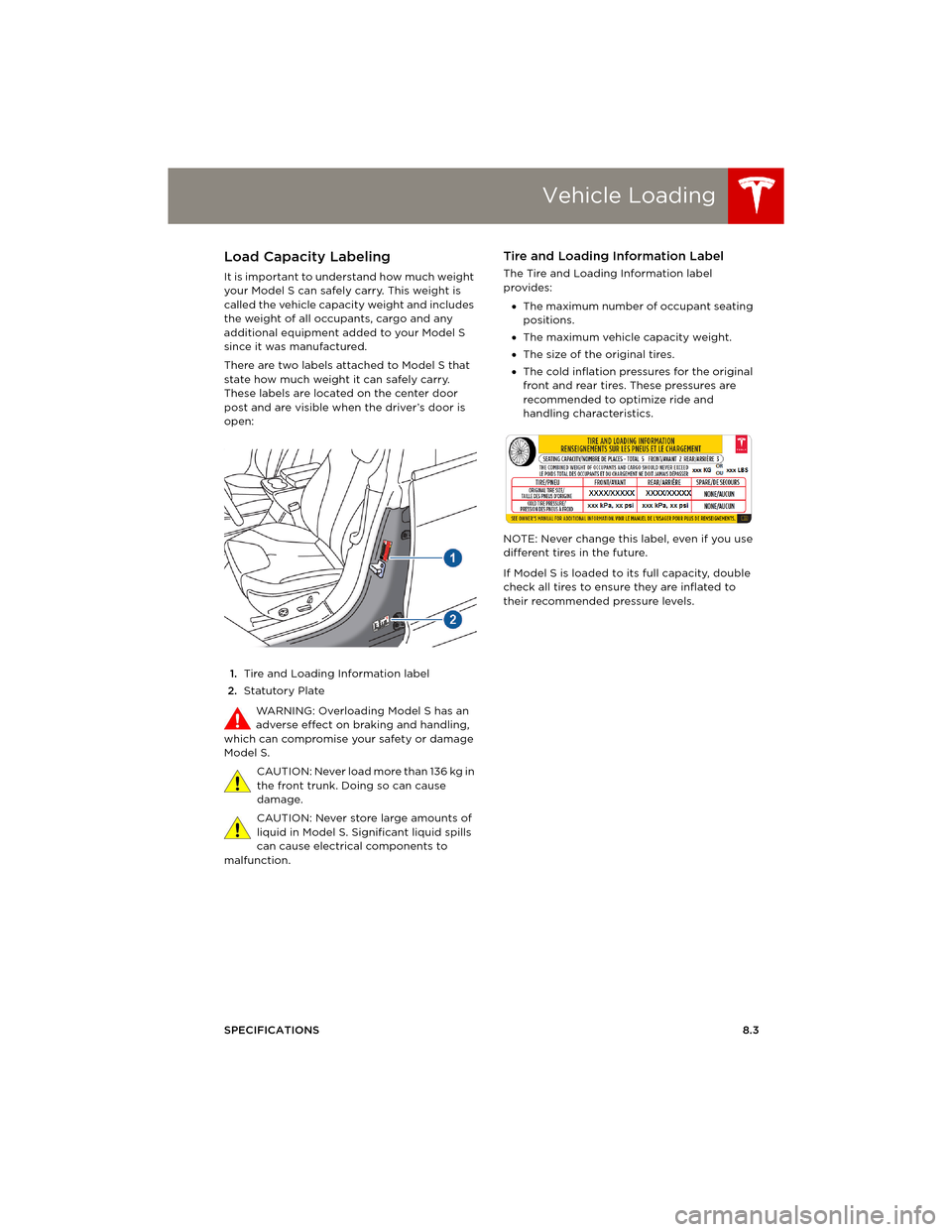
Vehicle Loading
SPECIFICATIONS8.3
Ve h i c l e L o a d i n gLoad Capacity Labeling
It is important to understand how much weight
your Model S can safely carry. This weight is
called the vehicle capacity weight and includes
the weight of all occupants, cargo and any
additional equipment added to your Model S
since it was manufactured.
There are two labels attached to Model S that
state how much weight it can safely carry.
These labels are located on the center door
post and are visible when the driver’s door is
open:
1.Tire and Loading Information label
2.Statutory Plate
WARNING: Overloading Model S has an
adverse effect on braking and handling,
which can compromise your safety or damage
Model S.
C A U T I O N : N e v e r l o a d m o r e t h a n 1 3 6 k g i n
the front trunk. Doing so can cause
damage.
CAUTION: Never store large amounts of
liquid in Model S. Significant liquid spills
can cause electrical components to
malfunction.
Tire and Loading Information Label
The Tire and Loading Information label
provides:
•The maximum number of occupant seating
positions.
•The maximum vehicle capacity weight.
•The size of the original tires.
•The cold inflation pressures for the original
front and rear tires. These pressures are
recommended to optimize ride and
handling characteristics.
NOTE: Never change this label, even if you use
different tires in the future.
If Model S is loaded to its full capacity, double
check all tires to ensure they are inflated to
their recommended pressure levels.
book.book Page 3 Friday, July 19, 2013 12:53 PM
Page 126 of 152
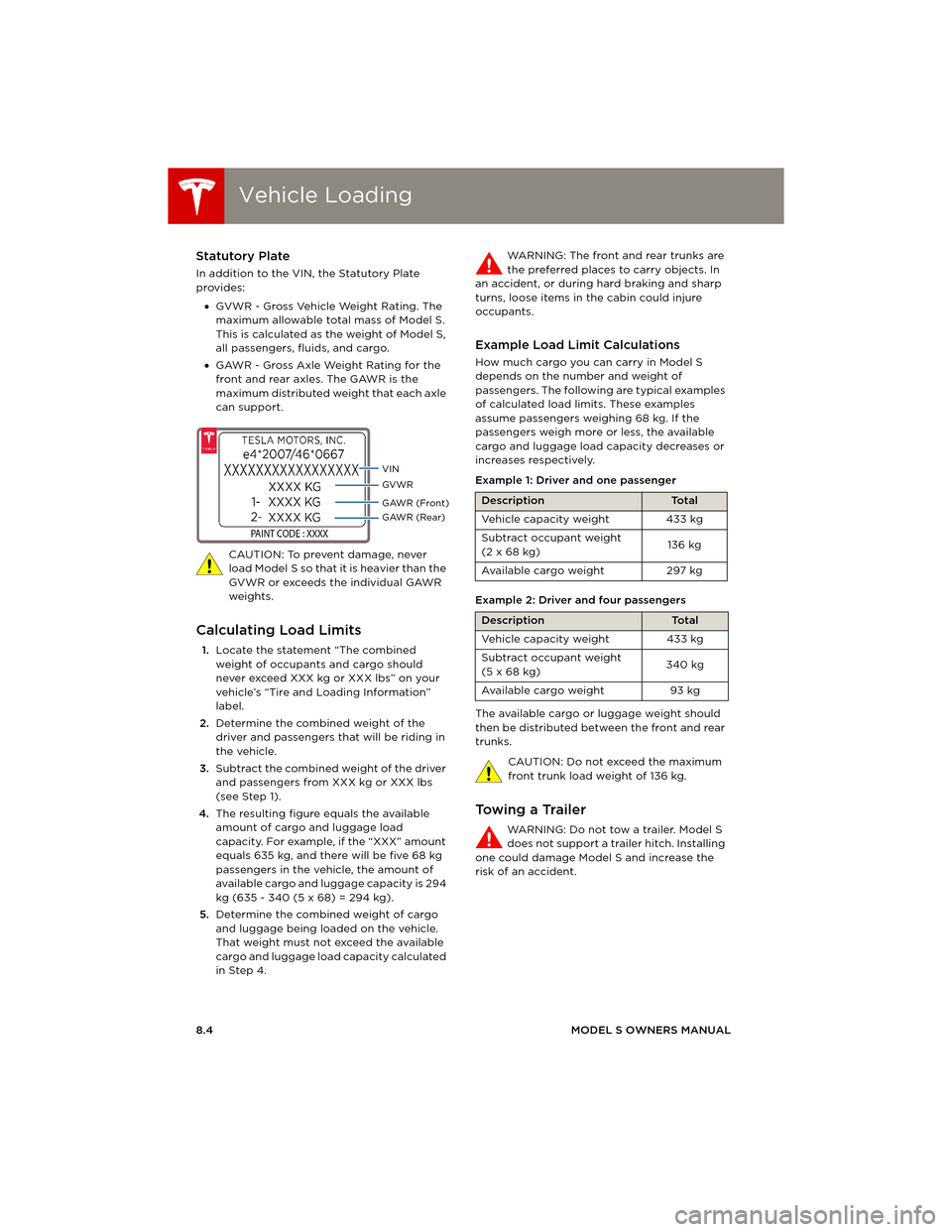
Vehicle LoadingVehicle Loading
8.4MODEL S OWNERS MANUAL
Statutory Plate
In addition to the VIN, the Statutory Plate
provides:
•GVWR - Gross Vehicle Weight Rating. The
maximum allowable total mass of Model S.
This is calculated as the weight of Model S,
all passengers, fluids, and cargo.
•GAWR - Gross Axle Weight Rating for the
front and rear axles. The GAWR is the
maximum distributed weight that each axle
can support.
CAUTION: To prevent damage, never
load Model S so that it is heavier than the
GVWR or exceeds the individual GAWR
weights.
Calculating Load Limits
1.Locate the statement “The combined
weight of occupants and cargo should
never exceed XXX kg or XXX lbs” on your
vehicle’s “Tire and Loading Information”
label.
2.Determine the combined weight of the
driver and passengers that will be riding in
the vehicle.
3.Subtract the combined weight of the driver
and passengers from XXX kg or XXX lbs
(see Step 1).
4.The resulting figure equals the available
amount of cargo and luggage load
capacity. For example, if the “XXX” amount
equals 635 kg, and there will be five 68 kg
passengers in the vehicle, the amount of
available cargo and luggage capacity is 294
kg (635 - 340 (5 x 68) = 294 kg).
5.Determine the combined weight of cargo
and luggage being loaded on the vehicle.
That weight must not exceed the available
cargo and luggage load capacity calculated
in Step 4. WARNING: The front and rear trunks are
the preferred places to carry objects. In
an accident, or during hard braking and sharp
turns, loose items in the cabin could injure
occupants.
Example Load Limit Calculations
How much cargo you can carry in Model S
depends on the number and weight of
passengers. The following are typical examples
of calculated load limits. These examples
assume passengers weighing 68 kg. If the
passengers weigh more or less, the available
cargo and luggage load capacity decreases or
increases respectively.
Example 1: Driver and one passenger
Example 2: Driver and four passengers
The available cargo or luggage weight should
then be distributed between the front and rear
trunks.
CAUTION: Do not exceed the maximum
front trunk load weight of 136 kg.
Towing a Trailer
WARNING: Do not tow a trailer. Model S
does not support a trailer hitch. Installing
one could damage Model S and increase the
risk of an accident.
DescriptionTo t a l
Vehicle capacity weight 433 kg
Subtract occupant weight
(2 x 68 kg)136 kg
Ava i l a b l e c a rg o we i g h t 2 97 kg
DescriptionTo t a l
Vehicle capacity weight 433 kg
Subtract occupant weight
(5 x 68 kg)340 kg
Ava i l a b l e c a rg o we i g h t 93 kg
book.book Page 4 Friday, July 19, 2013 12:53 PM
Page 127 of 152
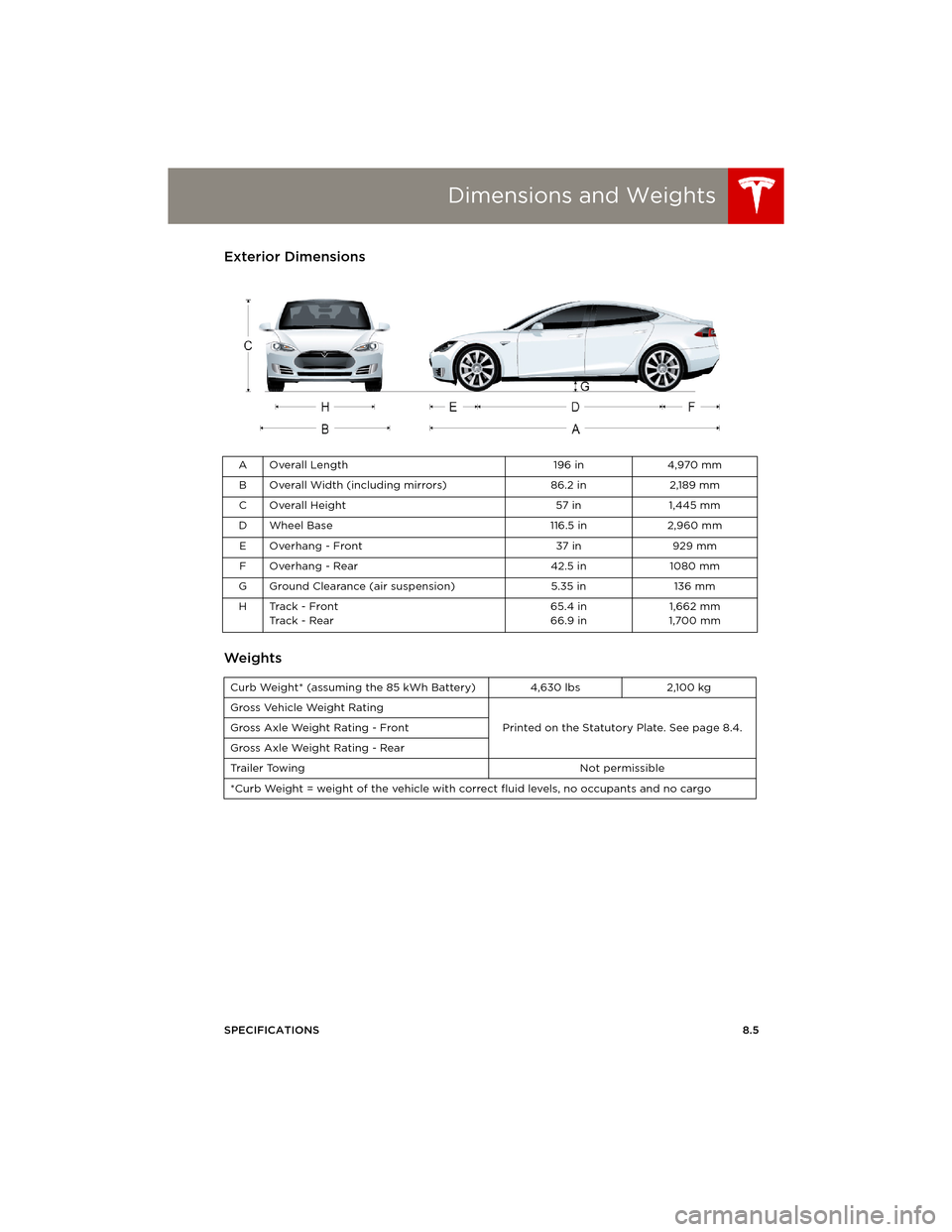
Dimensions and Weights
SPECIFICATIONS8.5
Dimensions and WeightsExterior Dimensions
Weights
AOverall Length 196 in 4,970 mm
B Overall Width (including mirrors) 86.2 in 2,189 mm
C Overall Height 57 in 1,445 mm
D Wheel Base 116.5 in 2,960 mm
EOverhang - Front 37 in 929 mm
F Overhang - Rear 42.5 in 1080 mm
G Ground Clearance (air suspension) 5.35 in 136 mm
HTrack - Front
Track - Rear65.4 in
66.9 in1,662 mm
1,700 mm
Curb Weight* (assuming the 85 kWh Battery) 4,630 lbs 2,100 kg
Gross Vehicle Weight Rating
Printed on the Statutory Plate. See page 8.4. Gross Axle Weight Rating - Front
Gross Axle Weight Rating - Rear
Trailer Towing Not permissible
*Curb Weight = weight of the vehicle with correct fluid levels, no occupants and no cargo
book.book Page 5 Friday, July 19, 2013 12:53 PM
Page 128 of 152
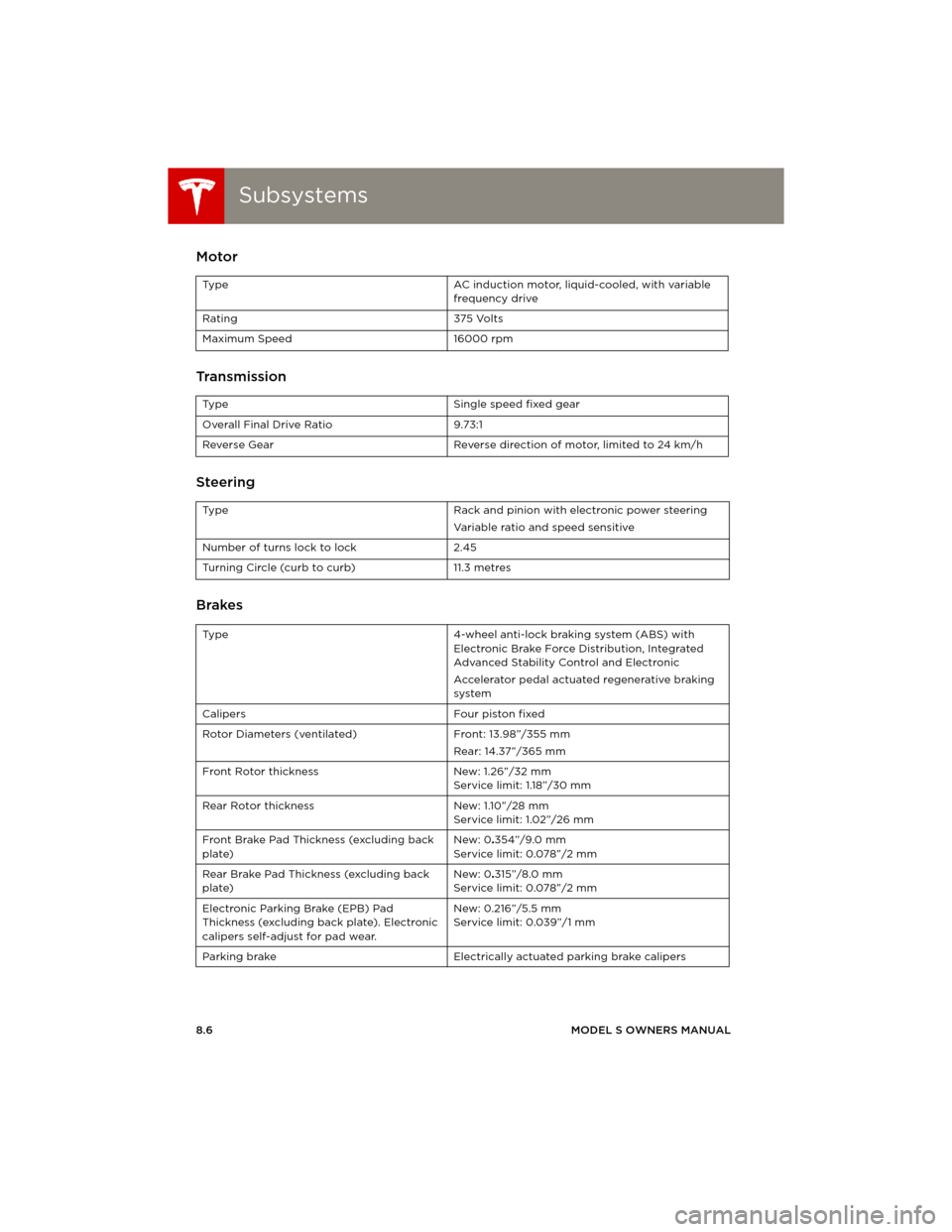
SubsystemsSubsystems
8.6MODEL S OWNERS MANUAL
SubsystemsMotor
Transmission
Steering
Brakes
Type AC induction motor, liquid-cooled, with variable
frequency drive
Rating 375 Volts
Maximum Speed 16000 rpm
Type Single speed fixed gear
Overall Final Drive Ratio 9.73:1
Reverse Gear Reverse direction of motor, limited to 24 km/h
Type Rack and pinion with electronic power steering
Variable ratio and speed sensitive
Number of turns lock to lock 2.45
Turning Circle (curb to curb) 11.3 metres
Type 4-wheel anti-lock braking system (ABS) with
Electronic Brake Force Distribution, Integrated
Advanced Stability Control and Electronic
Accelerator pedal actuated regenerative braking
system
Calipers Four piston fixed
Rotor Diameters (ventilated) Front: 13.98”/355 mm
Rear: 14.37”/365 mm
Front Rotor thickness New: 1.26”/32 mm
Service limit: 1.18”/30 mm
Rear Rotor thickness New: 1.10”/28 mm
Service limit: 1.02”/26 mm
Front Brake Pad Thickness (excluding back
plate)New: 0.354”/9.0 mm
Service limit: 0.078”/2 mm
Rear Brake Pad Thickness (excluding back
plate)New: 0.315”/8.0 mm
Service limit: 0.078”/2 mm
Electronic Parking Brake (EPB) Pad
Thickness (excluding back plate). Electronic
calipers self-adjust for pad wear.New: 0.216”/5.5 mm
Service limit: 0.039”/1 mm
Parking brake Electrically actuated parking brake calipers
book.book Page 6 Friday, July 19, 2013 12:53 PM
Page 129 of 152
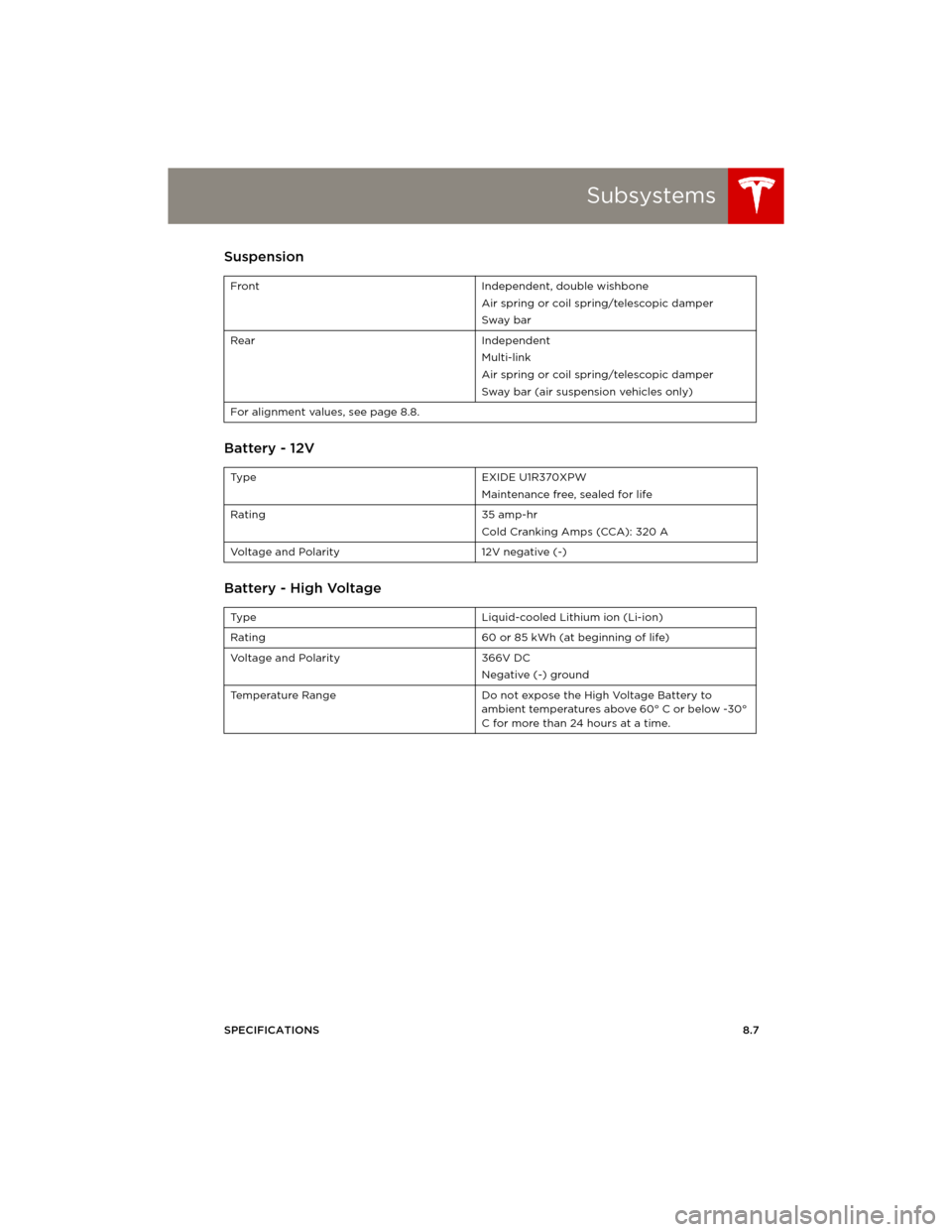
Subsystems
SPECIFICATIONS8.7
Suspension
Battery - 12V
Battery - High Voltage
Front Independent, double wishbone
Air spring or coil spring/telescopic damper
Sway bar
Rear Independent
Multi-link
Air spring or coil spring/telescopic damper
Sway bar (air suspension vehicles only)
For alignment values, see page 8.8.
Ty p e E X I D E U 1 R 3 7 0 X P W
Maintenance free, sealed for life
Rating 35 amp-hr
Cold Cranking Amps (CCA): 320 A
Voltage and Polarity 12V negative (-)
Type Liquid-cooled Lithium ion (Li-ion)
Rating 60 or 85 kWh (at beginning of life)
Voltage and Polarity 366V DC
Negative (-) ground
Temperature Range Do not expose the High Voltage Battery to
ambient temperatures above 60° C or below -30°
C for more than 24 hours at a time.
book.book Page 7 Friday, July 19, 2013 12:53 PM
Page 130 of 152
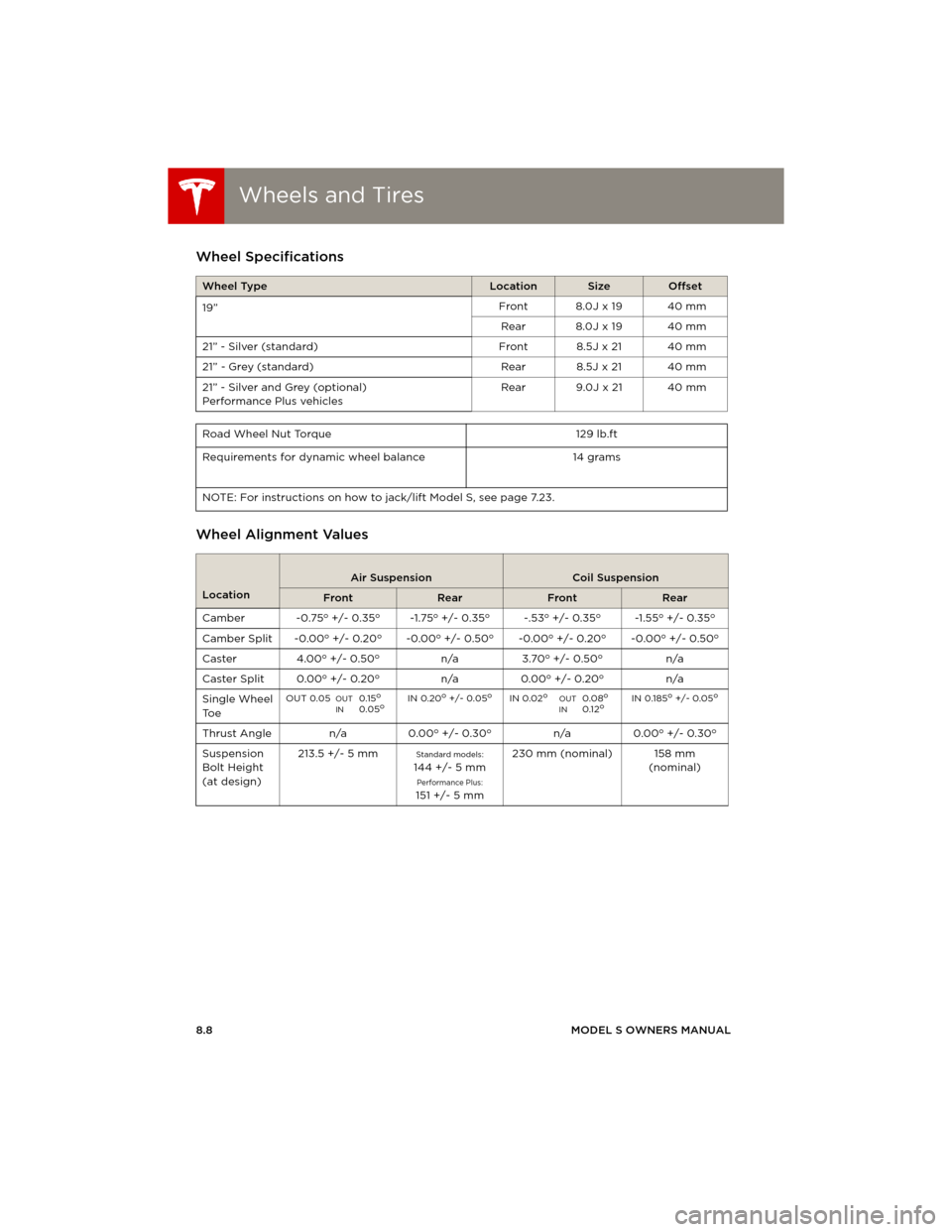
Wheels and TiresWheels and Tires
8.8MODEL S OWNERS MANUAL
Wheels and TiresWheel Specifications
Wheel Alignment Values
Wheel TypeLocationSizeOffset
19”Front 8.0J x 19 40 mm
Rear 8.0J x 19 40 mm
21” - Silver (standard) Front 8.5J x 21 40 mm
21” - Grey (standard) Rear 8.5J x 21 40 mm
21” - Silver and Grey (optional)
Performance Plus vehiclesRear 9.0J x 21 40 mm
Road Wheel Nut Torque 129 lb.ft
Requirements for dynamic wheel balance 14 grams
NOTE: For instructions on how to jack/lift Model S, see page 7.23.
Location
Air SuspensionCoil Suspension
FrontRearFrontRear
Camber -0.75
o +/- 0.35o-1.75o +/- 0.35o-.53o +/- 0.35o-1.55o +/- 0.35o
Camber Split -0.00o +/- 0.20o-0.00o +/- 0.50o-0.00o +/- 0.20o-0.00o +/- 0.50o
Caster 4.00o +/- 0.50on/a 3.70o +/- 0.50on/a
Caster Split 0.00
o +/- 0.20on/a 0.00o +/- 0.20on/a
Single Wheel
To e
OUT 0.05OUT0.15oIN0.05oIN 0.20o +/- 0.05oIN 0.02oOUT0.08oIN0.12oIN 0.185o +/- 0.05o
Thrust Angle n/a 0.00o +/- 0.30on/a 0.00o +/- 0.30o
Suspension
Bolt Height
(at design)213.5 +/- 5 mmStandard models:144 +/- 5 mmPerformance Plus:151 +/- 5 mm230 mm (nominal) 158 mm
(nominal)
book.book Page 8 Friday, July 19, 2013 12:53 PM